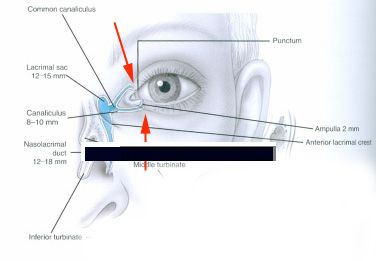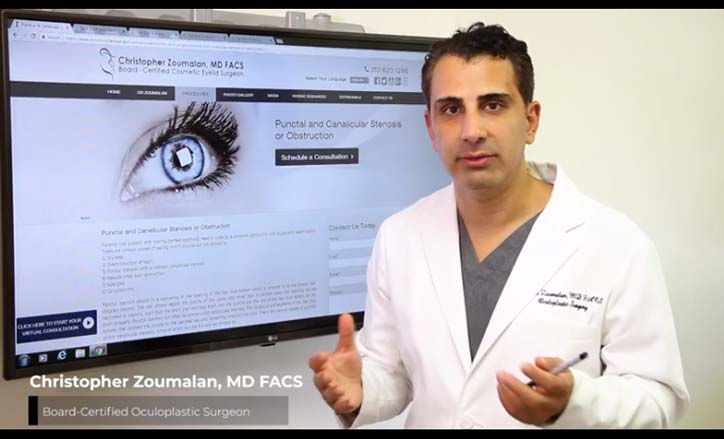Punctal and Canalicular Stenosis or Obstruction
Patients that present with tearing (termed epiphora) need to undergo a complete ophthalmic and oculoplastic examination. There are various causes of tearing which include but not limited to:
- Dry eyes
- Overproduction of tears
- Punctal stenosis with or without canalicular stenosis
- Nasolacrimal duct obstruction
- Allergies
- Conjunctivitis
Punctal stenosis results in a narrowing in the opening of the tear duct system which is referred to as the puncta (see diagram below). The red arrows depict the puncta of the upper and lower lids. In certain cases the opening can be narrowed or stenotic such that the tears that normally drain into the puncta and the rest of the tear duct system do not drain properly. Punctal stenosis can often be present with canalicular stenosis. The canaliculi are segments of the tear duct system that connect the puncta to the lacrimal sac and remaining nasolacrimal duct. There are various causes of punctal and/or canalicular stenosis, some of which include but are not limited to:
- Blepharitis
- Medication related
- topical eye (ophthalmic) medications
- systemic medications including certain chemotherapy medications such as Taxotere and 5-fluorouracil (5-FU)
- Chronic conjunvitis (allergic or infectious)
- Eyelid malpositions (such as entropions and ectropions)
- Trauma
- Eyelid neoplasms (benign or malignant)
- Uncertain etiology

Management involves diagnosis of punctual with or without canalicular stenosis and identification of the etiology (or cause). In the cases that the cause is identified it should be avoided if possible or treated (such as in those cases of allergic conjunctivitis or blepharitis). If the stenosis is only around the puncta, close management with topical medications can often help in improving the stenosis. However, patients may require a minor procedure to enlarge the stenotic puncta which is termed a punctoplasty procedure. This procedure can be performed in the office under local anesthesia and patients tolerate it very well.
If the puncta and canalicular system are stenotic and conservative treatment has not improved the situation, timely insertion of silicone tubes should be placed within the puncta and canalicular system in order to prevent continued and worsening stenosis. In cases that the cause cannot be avoided (such as in those particular patients undergoing chemotherapy), timely insertion of silicone tubes during the course interval of the chemotherapy regimen is necessary in order to prevent complete obstruction.



